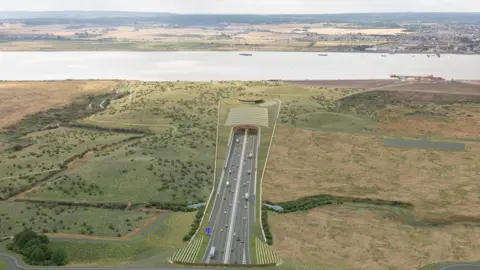The Lower Thames Crossing, a pivotal infrastructure project linking Tilbury in Essex to Gravesend in Kent, is set to adopt a novel environmental scheme designed to streamline building regulations and approvals. This initiative marks a significant milestone as it represents the first major construction effort to implement a new methodology aimed at reducing bureaucratic delays traditionally associated with environmental compliance.
According to government announcements, the project will consist of two new tunnels under the River Thames. This ambitious plan not only addresses the pressing need for improved transport links between Essex and Kent but also serves as a test case for the innovative measures proposed under the new regulatory framework. This framework is spearheaded by the appointment of a lead environmental regulator tasked specifically with overseeing the project’s environmental compliance efforts.
Natural England has been designated as the primary environmental overseer for this grand undertaking. This agency will collaborate closely with several advisory bodies, including the Environment Agency and the Marine Management Organisation, which will provide guidance and support throughout the project’s trajectory. By centralizing oversight through Natural England, the government aims to catalyze a more efficient process in acquiring planning permission and securing necessary environmental approvals.
The overarching goal of this new operational model is to reduce the time and complexity traditionally associated with navigating environmental regulations in major infrastructure projects. As noted by the Department for Environment, Food and Rural Affairs (Defra), the new scheme has the potential to significantly lower costs alongside the expedited approval process. The effective identification and escalation of any issues that obstruct the construction of the tunnel will be managed through Defra’s new infrastructure board, which aims to resolve such matters swiftly and efficiently.
The appointment of a lead environmental regulator emerges from the recommendations outlined in the Corry Review, an in-depth analysis that scrutinized existing environmental regulations and their impact on proceeding with significant infrastructure projects. The review highlighted the challenges faced by projects plagued by bureaucratic impasses, calling for reforms to facilitate smoother progress and mitigate the risk of stagnation.
In tandem with the announcement regarding the environmental framework, Environment Secretary Steve Reed emphasized the initiative’s benefits, stating, “Under the government’s Plan for Change, a new approach will see a lead environmental regulator appointed to smooth the system and keep projects firmly on track.” Reed articulated a broader vision where expedited developments in transport, energy, and housing sectors would contribute positively to both the economy and environmental safeguards.
As anticipation builds around the Lower Thames Crossing project, the government plans to provide additional updates on how it intends to implement other recommendations from the Corry Review, with ministers expected to elaborate on these plans in the coming week.
The Lower Thames Crossing represents not only a crucial transport link designed to alleviate congestion and enhance connectivity in the region but also a progressive shift in how large infrastructure projects are managed vis-à-vis environmental concerns. The implications of this initiative extend beyond just transportation logistics; it may also serve as a model for future projects, setting a precedent for balancing developmental needs with ecological responsibilities.
By investing in a streamlined regulatory approach, the government aims to address the long-standing frustrations associated with project delays, simultaneously protecting vital environmental interests. Should the Lower Thames Crossing prove successful, it could pave the way for a new era of more agile infrastructure planning in the United Kingdom, championing both economic growth and environmental preservation as fundamental considerations. Thus, the Lower Thames Crossing is not merely a transportation project but a transformative step towards modernizing and optimizing infrastructure development in a way that aligns with contemporary environmental standards. The project is charted to make significant waves and possibly redefine how the United Kingdom undertakes ambitious construction projects henceforth.











